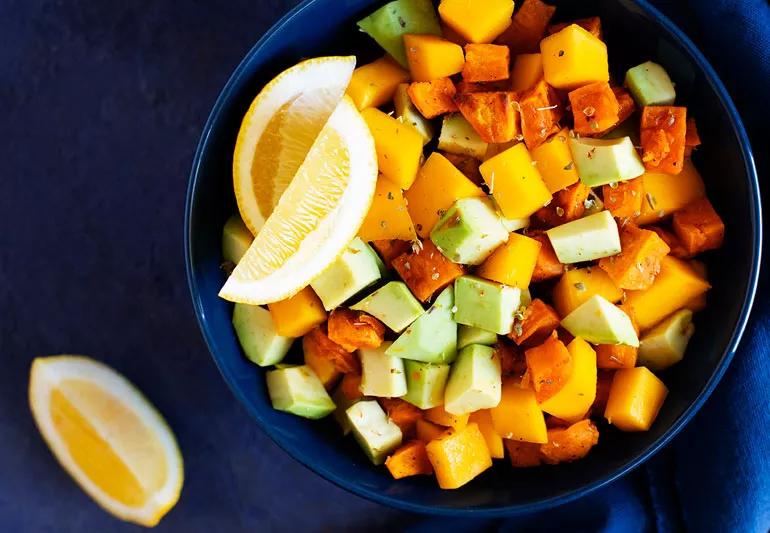Learn the benefits of going pegan and how to follow the diet

The paleo diet and a vegan diet don’t have much in common. One focuses on meat, while the other excludes it. But what if you take some qualities from both diets and combine them into one? Enter the pegan (paleo + vegan) diet.
Advertisement
Cleveland Clinic is a non-profit academic medical center. Advertising on our site helps support our mission. We do not endorse non-Cleveland Clinic products or services. Policy
Registered dietitian nutritionist Rosemarie Lembo James, RD, CNSC, LDN, explains the benefits and drawbacks of this plan and whether it might be right for you.
Functional medicine specialist Mark Hyman, MD, created the pegan diet, which he says:
“Like the paleo diet, the pegan diet focuses on foods that early humans would have hunted or gathered,” explains Lembo James. “But the twist is that most of your daily food intake will be plants. You eat much lower amounts of animal-based foods than you would eat on the paleo diet.”
If you eat pegan:
Going pegan means you can eat:
Advertisement
You can also eat minimal amounts of:
The pegan diet doesn’t tell you how much you can eat or when. But a pegan diet severely limits or skips certain foods, including:
If you follow the pegan diet closely, you’ll load up on fruits and vegetables. “A focus on fresh produce is a positive aspect of the pegan diet,” says Lembo James. “These foods are packed with vitamins, minerals and fiber and are usually low in calories.”
Avoiding sugar and processed foods is another plus for this eating plan. “Most Americans eat too much sugar and processed foods,” says Lembo James. “These foods tend to be low in nutrition. In addition, sugary foods can make you feel hungry, which can lead to eating more and unwanted weight gain.”
The pegan diet isn’t perfect, however. It cuts out almost all legumes and grains, which are important sources of B vitamins and fiber. And unless you’re using a dairy substitute regularly, you could miss out on calcium and protein from dairy products.
“Fruits and vegetables are great choices — but they can’t give you all the nutrients you need,” says Lembo James. “Make sure you’re getting enough protein, iron and vitamin B12, which are found in meat, eggs and tofu. You also need at least 1,000 milligrams a day of calcium — older or pregnant adults need even more. Talk to your doctor or a registered dietitian to figure out how to get your daily calcium intake.”
The pegan diet has some benefits, but don’t jump in without asking your healthcare provider. “Proceed with caution anytime a diet eliminates entire food groups,” says Lembo James. “And the pegan diet may not be suitable at all for people who have health conditions like an iron or B12 deficiency. If you have osteoporosis, work with your provider to get the vitamin D and calcium your bones need.”
If you’re trying to cut your grocery budget, a strict pegan diet won’t be your friend. Organic and grass-fed meats cost much more than non-organic options. And without beans or legumes, you lose a good source of inexpensive, meatless protein.
You don’t have to go full pegan to reap some of the benefits of this lifestyle. “Eating more fruits and vegetables can lower your risk of heart attack, stroke and cancer,” says Lembo James. “But don’t skimp on dairy, legumes and whole grains without talking to your doctor or nutritionist.”
Advertisement
Learn more about our editorial process.
Advertisement

Choose foods that are low in fiber and easy to chew and swallow

The flexible eating plan aims to boost your brain health by focusing on plant-based foods and limiting saturated fat

Designed to lower your blood pressure, this eating plan focuses on heart-healthy foods like whole grains, fruits and vegetables

Pescatarians don’t eat poultry, game or red meat, but they do eat fish and seafood, dairy and eggs

This eating style has many health benefits, including weight loss, an improved microbiome, and increased nutrient and mineral consumption

Research shows promising results from options like the DASH diet and Mediterranean diet

Some people can safely lose weight on just 1,200 calories — but it’s not right for everyone

The Mediterranean diet, DASH diet or more plant-based eating plans can improve heart health

Babies can get congested easily, but you can calm their cough by keeping them hydrated, using nasal drops and running a humidifier

Weight loss may cause loose, sagging skin and muscle loss to your rear

Several conditions, like vitiligo and fungal infection, can cause a loss of pigmentation, leading to white spots or patches on your skin